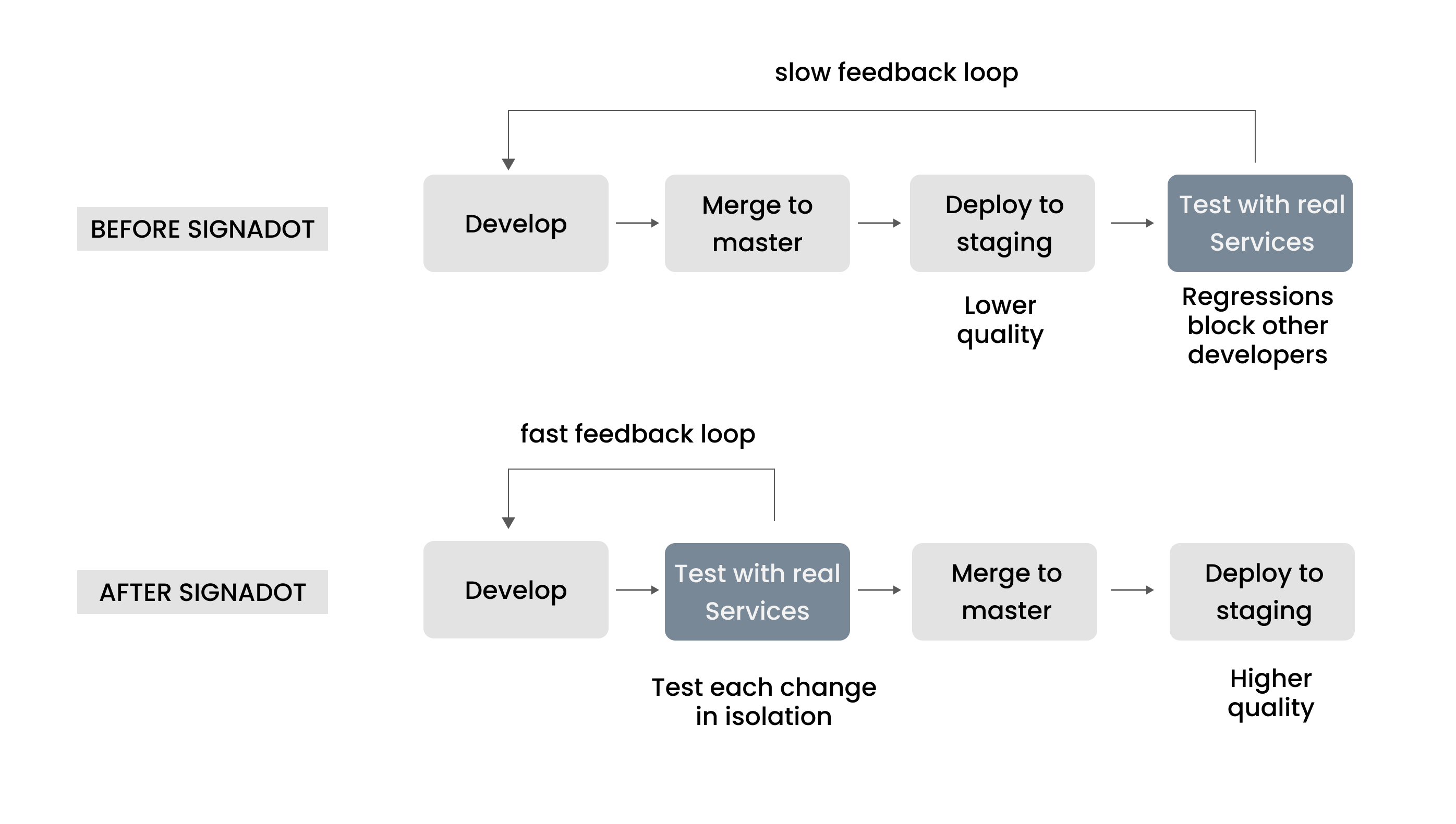Signadot Documentation Overview
Introduction
Welcome to the official documentation for Signadot.
Signadot is a Kubernetes-native platform that accelerates the development of complex, distributed applications. You can use it to ship faster and with more confidence by getting high-fidelity, ephemeral environments for every code change.

Core Capabilities
Environments
- Local Development: Test your changes from your local workstation against real dependencies, like production scale databases or vector stores, in a shared cluster environment, all without building images or pushing code.
- Pull Request Previews: Create isolated, full-stack environments for each PR. This allows you to visually inspect and validate changes, from UI tweaks to API changes, in the context of all real dependencies, including databases and third-party APIs.
Testing
- Integration & E2E Testing: Run complex integration and end-to-end test suites against ephemeral, production-like environments on every PR. Use Signadot Jobs to execute your tests directly within Kubernetes on Pull Request sandboxes, reliably testing the full chain of interactions between your services, from the API gateway down to the database and 3rd party APIs, catching integration issues before they merge.
- Smart Tests: Validate API behavior without writing brittle assertions. AI powered "Smart Diff" automatically compares the output of a new version against the baseline, allowing you to assess the impact of a change by observing the resulting difference in behavior.
- Synthetic API Tests: Effortlessly create synthetic smoke tests for any API endpoint to perform continuous health monitoring.
How It Works
Signadot installs into your Kubernetes cluster and connects to a remote control plane. It creates isolated sandboxes within shared clusters through several isolation mechanisms.
Request routing is handled either by the built-in devmesh for HTTP/gRPC traffic, or through service mesh integration (Istio, Linkerd) for advanced use cases. Both approaches use standard header propagation protocols like OpenTelemetry or B3 to split traffic between sandbox and baseline environments.
For asynchronous workflows, Signadot provides message queue isolation through libraries supporting Kafka, RabbitMQ, and other message queues. These libraries create sandbox-specific topics and queues, maintaining message ordering while automatically cleaning up resources when sandboxes are deleted.
Data isolation is achieved through resource plugins for stateful components like databases. These plugins create temporary schemas or databases for sandboxes with minimal overhead, enabling proper isolation of data changes while maintaining efficiency in shared resources.
This architecture is similar to systems like SLATE at Uber and Staging Overrides at Lyft.
Key Benefits
- Developer Experience: A unified platform for local development and Pull Request previews. Developers use the same system for iterating from their workstations, testing changes, and previewing Pull Requests, eliminating context switching and tool fragmentation.
- High-Fidelity Environments: Teams test against production-grade data and real dependencies without mocks. Isolated sandboxes in shared environments enable safe testing without disrupting others.
- Resource Efficiency: Signadot creates lightweight sandboxes that share a single Kubernetes cluster. By sharing resources across sandboxes instead of duplicating entire environments, it dramatically reduces infrastructure costs and operational overhead.
- Shift-Left Testing: Teams run integration, end-to-end, and API tests during development using Signadot Jobs and Smart Tests. Smart Tests with Smart Diff provide zero-maintenance API validation. This enables early issue detection and faster feedback cycles when changes are cheapest to fix.
Getting Started
- Set up local development
- Set up preview environments for your Pull Requests
- Run jobs on your sandboxes for testing
- Run Smart Tests on your sandboxes
For detailed architecture and concepts, see our technical documentation.